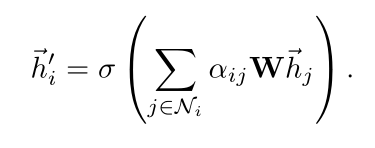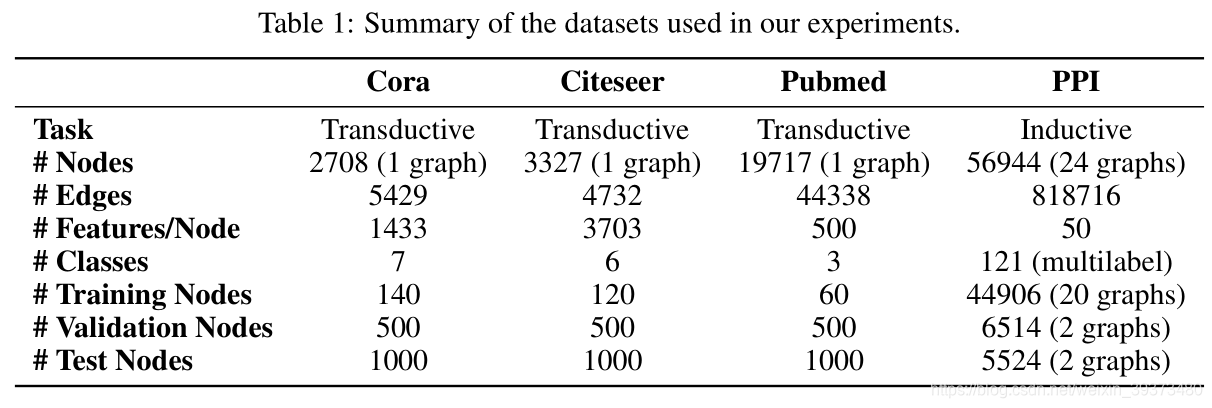Graph Attention Networks
1. 创新点
通过新型神经网络对图形结构数据进行操作,利用隐藏的自注意层赋予邻域节点不同重要性,并无需提前了解整个网络结构
通过堆叠这样的一些层,这些层里的节点能够注意其邻近节点的特征,不需要进行成本高昂的矩阵运算(例如反演),也无需事先知道图的结构
1.1. attention 引入目的
- 为每个节点分配不同权重
- 关注那些作用比较大的节点,而忽视一些作用较小的节点
- 在处理局部信息的时候同时能够关注整体的信息,不是用来给参与计算的各个节点进行加权的,而是表示一个全局的信息并参与计算
1.2. 框架特点
- attention 计算机制高效,为每个节点和其每个邻近节点计算attention 可以并行进行
- 能够按照规则指定neighbor 不同的权重,不受邻居数目的影响
- 可直接应用到归纳推理问题中
2. 模型
2.1. feature 处理
通过线性变换生成新的更强的 feature
输入:node feature的集合

( N 为node 数量, F 为每个node 的 feature 数–feature vector 长度)
输出:

( 使用W 将每个特征转换为可用的表达性更强的特征)
2.2. 计算相互关注
每两个node 间都有了相互关注机制(用来做加权平均,卷积时,每个node 的更新是其他的加权平均
共享的关注机制
通过node feature 计算两个node 间的关系

用来做加权平均需要转换一下参数

(这个系数 α 就是每次卷积时,用来进行加权求和的系数)
本文采取的计算attention coefficient的函数a是一个单层的前馈网络,LeakyReLU 处理得

( || 表示串联/ 连接,一旦获得,归一化的相互注意系数用来计算对应特征的线性组合,以用作每个节点的最终输出特征)

左图:
在模型中应用注意机制
,通过权重向量 a 参数化,应用 LeakyReLU 激活
右图:
节点
在邻域中具有多端连接,不同的箭头样式表示独立的注意力计算,通过直连concat或平均avg获取
。
2.3 multi-head attention机制
- 不只用一个函数a进行attention coefficient的计算,而是设置K个函数,每一个函数都能计算出一组attention coefficient,并能计算出一组加权求和用的系数,每一个卷积层中,K个attention机制独立的工作,分别计算出自己的结果后连接在一起,得到卷积的结果,即

- 假如有 k 个独立的相互注意机制同时计算,则集中其特征,可得到特征表示

- 对于最后一个卷积层,如果还是使用multi-head attention机制,那么就不采取连接的方式合并不同的attention机制的结果了,而是采用求平均的方式进行处理,即

3.对比
- 计算很高效,attention机制在所有边上的计算是可以并行的,输出的feature的计算在所有节点上也可以并行
- 和GCN不同,本文的模型可以对同一个结点的相邻结点分配不同的重要性,使得模型的容量(自由度)大增。
- 分析这些学到的attentional weights有利于可解释性(可能是分析一下模型在分配不同的权重的时候是从哪些角度着手的)
- attention机制是对于所有edge共享的,不需要依赖graph全局的结构以及所有node的特征
- 2017年Hamilton提出的inductive method 对于neighborhood的模式处理固定,不灵活
4.实验结果

5. 实现细节
5.1 代码解析
以pytorch版本的代码为例,解读如下:
- 读入数据:
可见 Cora数据集介绍+读取 - 网络的总体架构
class GAT(nn.Module):
def __init__(self, nfeat, nhid, nclass, dropout, alpha, nheads):
"""
Dense version of GAT.
:param nfeat: 输入特征的维度
:param nhid: 输出特征的维度
:param nclass: 分类个数
:param dropout: dropout
:param alpha: LeakyRelu中的参数
:param nheads: 多头注意力机制的个数
"""
super(GAT, self).__init__()
self.dropout = dropout
# 多头注意力机制
self.attentions = [GraphAttentionLayer(nfeat, nhid, dropout=dropout, alpha=alpha, concat=True) for _ in range(nheads)]
for i, attention in enumerate(self.attentions):
self.add_module('attention_{}'.format(i), attention)
# 输出层只用一个注意力机制
self.out_att = GraphAttentionLayer(nhid * nheads, nclass, dropout=dropout, alpha=alpha, concat=False)
def forward(self, x, adj):
x = F.dropout(x, self.dropout, training=self.training)
x = torch.cat([att(x, adj) for att in self.attentions], dim=1) #(2708,64)
x = F.dropout(x, self.dropout, training=self.training)
x = F.elu(self.out_att(x, adj))
return F.log_softmax(x, dim=1)
- 注意力机制模块的实现
class GraphAttentionLayer(nn.Module):
"""
Simple GAT layer, similar to https://arxiv.org/abs/1710.10903
"""
def __init__(self, in_features, out_features, dropout, alpha, concat=True):
super(GraphAttentionLayer, self).__init__()
self.dropout = dropout
self.in_features = in_features
self.out_features = out_features
self.alpha = alpha
self.concat = concat
self.W = nn.Parameter(torch.zeros(size=(in_features, out_features)))
nn.init.xavier_uniform_(self.W.data, gain=1.414)
self.a = nn.Parameter(torch.zeros(size=(2*out_features, 1)))
nn.init.xavier_uniform_(self.a.data, gain=1.414)
self.leakyrelu = nn.LeakyReLU(self.alpha)
def forward(self, input, adj):
'''
:param input: 输入特征 (batch,in_features)
:param adj: 邻接矩阵 (batch,batch)
:return: 输出特征 (batch,out_features)
'''
h = torch.mm(input, self.W) # (batch,out_features)
N = h.size()[0] # batch
# 将不同样本之间两两拼接,形成如下矩阵
# [[结点1特征,结点1特征],
# [结点1特征,结点2特征],
# ......
# [结点1特征,结点j特征],
# [结点2特征,结点1特征],
# [结点2特征,结点2特征],
# ......
# ]
a_input = torch.cat([h.repeat(1, N) # (batch,out_features*batch)
.view(N * N, -1), # (batch*batch,out_features)
h.repeat(N, 1)], # (batch*batch,out_features)
dim=1).view(N, -1, 2 * self.out_features) # (batch,batch,2 * out_features)
# 通过刚刚的矩阵与权重矩阵a相乘计算每两个样本之间的相关性权重,最后再根据邻接矩阵置零没有连接的权重
e = self.leakyrelu(torch.matmul(a_input, self.a).squeeze(2)) # (batch,batch)
# 置零的mask
zero_vec = -9e15*torch.ones_like(e) # (batch,batch)
attention = torch.where(adj > 0, e, zero_vec) # (batch,batch) 有相邻就为e位置的值,不相邻则为0
attention = F.softmax(attention, dim=1) # (batch,batch)
attention = F.dropout(attention, self.dropout, training=self.training) # (batch,batch)
h_prime = torch.matmul(attention, h) # (batch,out_features)
if self.concat:
return F.elu(h_prime)
else:
return h_prime
5.2 其他细节
transductive learning
- 两层 GAT
- 在Cora 数据集上优化网络结构的超参数,应用到Citeseer 数据集
- 第一层 8 head, F`=8 ELU 作为非线性函数
- 第二层为分类层,一个 attention head 特征数C,后跟 softmax 函数
- 为了应对小训练集,正则化(L2)
- 两层都采用 0.6 的dropout
- 相当于计算每个node位置的卷积时都是随机的选取了一部分近邻节点参与卷积
inductive learning
- 三层GAT 模型
- 前两层 K=4, F1=256 ELU作为非线性函数
- 最后一层用来分类 K=6, F`=121 后跟logistics sigmoid 激活函数
- 该任务中,训练集足够大不需要使用 正则化 和 dropout
- 两个任务都是用Glorot初始化初始的,并且是用Adam SGD来最小化交叉熵进行优化